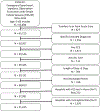Establishment of achievable benchmarks of care in the neurodiagnostic evaluation of simple febrile seizures
- PMID: 35560723
- PMCID: PMC11309806
- DOI: 10.1002/jhm.12833
Establishment of achievable benchmarks of care in the neurodiagnostic evaluation of simple febrile seizures
Abstract
Background: Current guidelines recommend against neurodiagnostic testing for the evaluation of simple febrile seizures.
Objectives: (1) Assess overall and institutional rates of neurodiagnostic testing and (2) establish achievable benchmarks of care (ABCs) for children evaluated for simple febrile seizures at children's hospitals.
Design, setting, and participants: Cross-sectional study of children 6 months to 5 years evaluated in the emergency department (ED) 2016-2019 with simple febrile seizures at 38 children's hospitals in Pediatric Health Information System database. We excluded children with epilepsy, complex febrile seizures, complex chronic conditions, and intensive care.
Outcome measures: Proportions of children who received neuroimaging, electroencephalogram (EEG), or lumbar puncture (LP) and rates of hospitalization for study cohort and individual hospitals. Hospital-specific outcomes were adjusted for patient demographics and severity of illness. We utilized hospital-specific values for each measure to calculate ABCs.
Results: We identified 51,015 encounters. Among the study cohort 821 (1.6%) children had neuroimaging, 554 (1.1%) EEG, 314 (0.6%) LP, and 2023 (4.0%) were hospitalized. Neurodiagnostic testing rates varied across hospitals: neuroimaging 0.4%-6.7%, EEG 0%-8.2%, LP 0%-12.7% in patients <1-year old and 0%-3.1% in patients ≥1 year. Hospitalization rate ranged from 0%-14.5%. Measured outcomes were higher among hospitalized versus ED-only patients: neuroimaging 15.3% versus 1.0%, EEG% 24.7 versus 0.1% (p < .001). Calculated ABCs were 0.6% for neuroimaging, 0.1% EEG, 0% LP, and 1.0% hospitalization.
Conclusions: Rates of neurodiagnostic testing and hospitalization for simple febrile seizures were low but varied across hospitals. Calculated ABCs were 0%-1% for all measures, demonstrating that adherence to current guidelines is attainable.
© 2022 Society of Hospital Medicine.
Conflict of interest statement
CONFLICTS OF INTEREST
The authors declare no conflicts of interest.
Figures






Similar articles
-
Trends in Management of Simple Febrile Seizures at US Children's Hospitals.Pediatrics. 2021 Nov;148(5):e2021051517. doi: 10.1542/peds.2021-051517. Epub 2021 Oct 20. Pediatrics. 2021. PMID: 34670823
-
Variability in Resource Utilization in the Evaluation and Management of Simple Febrile Seizures Inpatients in US Children's Hospitals.J Neurosurg Anesthesiol. 2023 Jan 1;35(1):153-159. doi: 10.1097/ANA.0000000000000887. Epub 2022 Dec 6. J Neurosurg Anesthesiol. 2023. PMID: 36745181
-
Simple febrile seizures: are the AAP guidelines regarding lumbar puncture being followed?Pediatr Emerg Care. 2009 Jan;25(1):8-11. doi: 10.1097/PEC.0b013e318191da93. Pediatr Emerg Care. 2009. PMID: 19116502
-
Evaluation and management of febrile seizures in the out-of-hospital and emergency department settings.Ann Emerg Med. 2003 Feb;41(2):215-22. doi: 10.1067/mem.2003.48. Ann Emerg Med. 2003. PMID: 12548271 Review.
-
Neurodiagnostic evaluation of the child with a simple febrile seizure.Pediatrics. 2011 Feb;127(2):389-94. doi: 10.1542/peds.2010-3318. Pediatrics. 2011. PMID: 21285335 Review.
Cited by
-
Changing patterns of routine laboratory testing over time at children's hospitals.J Hosp Med. 2024 Aug;19(8):671-679. doi: 10.1002/jhm.13372. Epub 2024 Apr 21. J Hosp Med. 2024. PMID: 38643414 Free PMC article.
References
-
- Steering Committee on Quality Improvement and Management, Subcommittee on Febrile Seizures American Academy of Pediatrics. Febrile seizures: clinical practice guideline for the long-term management of the child with simple febrile seizures. Pediatrics. 2008;121(6):1281–1286. - PubMed
-
- Subcommittee on Febrile Seizures; American Academy of Pediatrics. Neurodiagnostic evaluation of the child with a simple febrile seizure. Pediatrics. 2011;127(2):389–394. - PubMed
-
- Smith DK, Sadler KP, Benedum M. Febrile seizures: risks, evaluation, and prognosis. Am Fam Physician. 2019;99(7):445–450. - PubMed
MeSH terms
Grants and funding
LinkOut - more resources
Full Text Sources

